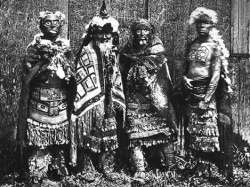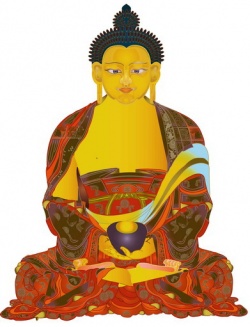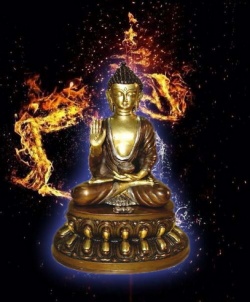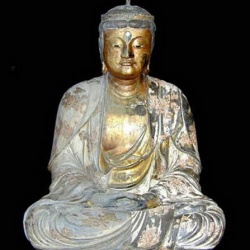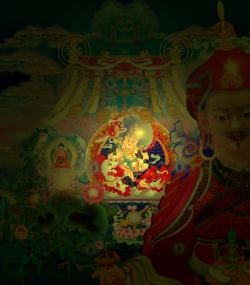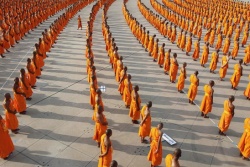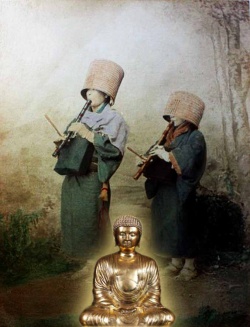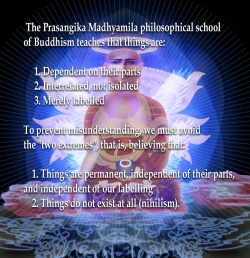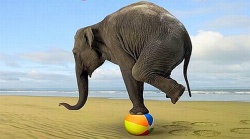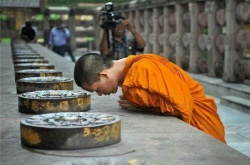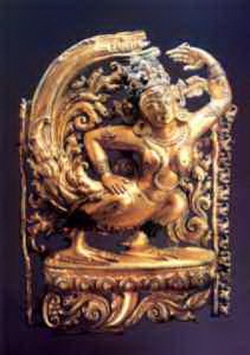Difference between revisions of "Maadhyamika"
m (Text replacement - "one thing " to "one thing ") |
|||
| (One intermediate revision by the same user not shown) | |||
| Line 78: | Line 78: | ||
To say that the yellow leaf is the green leaf of the {{Wiki|past}} is not correct. But again it cannot be said that it is something totally new - for then it would have come out of nowhere - it would have been uncaused, which is not possible because all things of the [[world]] are [[caused]]. That the yellow leaf is the same as the green leaf or the yellow leaf is different from the green leaf are both not feasible. So we're unable to establish either [[Wikipedia:Identity (social science)|identity]] or difference in [[causality]]. | To say that the yellow leaf is the green leaf of the {{Wiki|past}} is not correct. But again it cannot be said that it is something totally new - for then it would have come out of nowhere - it would have been uncaused, which is not possible because all things of the [[world]] are [[caused]]. That the yellow leaf is the same as the green leaf or the yellow leaf is different from the green leaf are both not feasible. So we're unable to establish either [[Wikipedia:Identity (social science)|identity]] or difference in [[causality]]. | ||
| − | Also how do we say | + | Also how do we say one thing is different from another? For a thing to be different from another, it depends upon its difference. But can we identify the difference as something apart from the thing itself? For the yellow leaf to be different from the green leaf, it depends upon its yellowness. But can we distinguish the yellowness as something apart from the leaf? No, it is an integral part of the leaf itself and neither the leaf nor the yellowness [[exists]] in itself - each depends on the other for its [[existence]]. So anything which depends on something else for its [[existence]] is neither the same or different from that on which it is dependent. So difference has [[no existence]] in itself and hence does not [[exist]]. |
Further the {{Wiki|concept}} of production itself is [[contradictory]]. | Further the {{Wiki|concept}} of production itself is [[contradictory]]. | ||
| Line 84: | Line 84: | ||
The seed gives rise to the sprout. It cannot be as the [[Saamkhyans]] asserted that the sprout existed in whole potentiality in the seed. For if it existed so, having all the necessary and sufficient [[conditions]] for its production, it would have become the sprout at once. In such a case a situation where the seed remained purely potential cannot be envisaged. | The seed gives rise to the sprout. It cannot be as the [[Saamkhyans]] asserted that the sprout existed in whole potentiality in the seed. For if it existed so, having all the necessary and sufficient [[conditions]] for its production, it would have become the sprout at once. In such a case a situation where the seed remained purely potential cannot be envisaged. | ||
| − | So is it that the seed with the aid of external [[conditions]] - sunshine and [[water]] and other | + | So is it that the seed with the aid of external [[conditions]] - sunshine and [[water]] and other favorable climatic [[conditions]], give rise to the sprout? |
The external [[conditions]] themselves will not do, else even a stone can sprout with the aid of sunshine and [[water]]. | The external [[conditions]] themselves will not do, else even a stone can sprout with the aid of sunshine and [[water]]. | ||
Latest revision as of 16:37, 30 January 2016
- "That things are unchanging (nitya), this Kaashyapa, is one end; that they are changing is another; that reality is substance (Atmeti) is one end; that it's only modal (nairaatmayam iti) is another end; the middle between these two extremes of the Atman and the nairaatmaya is the intangible, the incomparable, non appearing, not comprehensible, without any position; that verily is the Middle Path - the vision of the Real in its true form".
HISTORY AND LITERATURE
The Maadhyamika as the name suggests is the Middle Way, which can be traced to the original teaching of the Buddha. The founder of this system is Naagaarjuna (2nd century CE), a brahmin from Andhra, who is one of the greatest thinkers Bhaarath has produced.
A dialectician of great skill, Naagaarjuna quotes the Buddha from his dialogue with Katyaayaana (Kaccha) and tries to adopt the golden mean between extreme affirmation and extreme negation - between eternalism and nihilism.
He's both a skeptic and a mystic - the former as he realizes the essential relativity of thought and the latter due to his firm conviction of an absolute reality. He is a true philosopher who aims at thoroughness and completeness for their own sake.
Apart from his commentary of on the Praajnaapaaramitaa, Naagaarjuna is also the author of the Maadhyamika Shaastram, popularly known as the Mulamaadhyamika Kaarikaa.
His other works include Upaayakaushalyahrdhaya Shaastram, in which we find a clear exposition of the art of debate and Vigrahavyaavartani Kaarikaa, a polemic work against the Nyaaya school.
Shunyataa Saptati, Yukti Sastikaa, Vyavahaara Siddhi are other works attributed to Naagaarjuna which discuss Shunyavaada.
Ratnaavali and Suhrllekha are works on Mahaayaana practice.
In Catuh Stava, which contains feeling verses of the highest devotion, Naagaarjuna, like the other great aachaarya Shankara, reveals a well developed religious strain.
The later development of the Maadhyamika is represented by a series of great logicians : Aryadeva, Buddhapaalita, Bhaavaviveka, Chandrakirti, Shaantideva, Saankarakshita and Dharmasila.
Aryadeva was a direct disciple of Naagaarjuna. History has it that he was a prince from Sri Lanka and had a reputation as a ferocious debater. Catuhshataka, Akshara Shatakam, Hastavaala Prakarana, Chittavishuddhi Prakarna and Jnaanasaara Samuccaya are works attributed to Aryadeva.
Buddhapaalita and Bhaavaviveka initiate a new phase in the development of the Maadhyamaka system. While Buddhapaalita holds that Maadhyamikas should only reduce to absurdity the arguments of the opponent, Bhaavaviveka feels that after criticising the view of the opponent, the Maadhyamika can advance an opposite view. Buddhapaalita's school is the Prasangika and Bhaavaviveka's school is called Svaatantrika.
Both developed their respective standpoints by writing commentaries on the Maadhyamaka Shaastram of Naagaarjuna. Bhaavaviveka's other works are Tarkajvaala, Maadhyamikaartha Samgraha, Maadhyamikaavataara Pradiipa and Maadhyamika Pratitya Samutpaada. Bhaavaviveka was a liberal minded scholar who tried to bridge the Maadhyamika system with Brahmanical thought.
Chandrakirti is said to have been a native of South India. His Prasannapadaa is the classic commentary on the Mulamaadhyamika Kaarikaa and championing the cause of the Prasangikas he succeeds in driving the Svatantrika school of Bhaavaviveka into the shade.
Other works attributed to him are the Maadhyamikavataara, Maadhyamikapraajnavataara and Panchaskandha.
Shaantideva was the son of King Kalyaanavarman of Saurashtra. His Siksha Samuccaya and Bodhicaryaavataara are the two most popular works in the entire Mahaayaana literature. The latter is especially a deeply inspiring work on Mahaayaana spiritual practice.
Shaantarakshita and his disciple Kamalasila are credited with culturally conquering Tibet and making it a Buddhist nation. Shaantarakshita's works are the Tattvasangraha and Madhyamikalankaara Kaarikaa. Madhyamikaloka is a work attributed to Kamalasila.
MADHYAMA PRATHIPAD : THE MIDDLE WAY
In his dialogue with the wandering ascetic Vacchagotta, on being asked as to which metaphysical theory he supports the Buddha replies that he has "no theories". The reason for this he says is because, adoption of none of the theories is conducive to turning away from the world, meditation, tranquility and to achieving nirvaana. But inspite of this the Buddhist schools had come out with the theories of anatta (no substance) and kshanikavaada (momentariness) - according to them there was no substance in anything and only the modes which are momentary were true. Opposed to them was the other dominant tradition of the eternal Self (atmavaada) - the substance view - postulated by the Brahmanical schools. The Jainaas affirmed the reality of both the substance and modes, while the Charavaakas denied both. Indian philosophy had reached a stage where rival schools endorsed four diametrically opposed and contradictory doctrines - the four opposite ends of the philosophical spectrum.
To assert that "something is" - that there is a substance - is to force the aspirant to latch onto the thing - to grasp and this is not conducive to turning away from the world. To assert that there's no substance and only change (Hinayaanists) or to deny both, opens the aspirant to the psychological disadvantages of nihilism - loss of faith, virtue and enthusiasm for religion. The true philosophy must therefore help the aspirant transcend the unreal and work towards the Real without any such grasping or psychological disadvantages. Naagaarjuna endeavors to provide such a scheme. He equates our knowledge of the world to a city of Gaandharvas (celestial beings) - an illusion. And this illusion must be understood in three stages - the illusion of reason, the illusion of language and the illusion of the self.
DIALECTIC
Naagaarjuna mainly questions what we call as knowledge. For whatever we know of the world is dependent on our knowledge of it. He analyzes the validity of this knowledge.
Naagaarjuna opens up his Maadhyamika Shaastram with a salute to the Buddha who he says taught that in reality there's neither production nor destruction, neither nihilism nor eternalism, neither unity nor plurality, neither coming in nor going out (with regards liberation)!
Causality dialectically analyzed
Naagaarjuna opens up his deadly dialectic with an attack on causality. A thing is neither self-caused (Saamkhyan position), nor caused only by external conditions (Hinayaanists), nor caused by both itself and external conditions (Jainaas), nor neither caused by itself nor external events (Chaaravaaka nihilists).
There are two basic factors which make up causality : 1. the relation between cause and effect in the process of change and 2. the process of production.
The fundamental condition in causality is the relation between cause and effect. Is the cause identical with the effect? Or is the substance of the cause the same as the substance of the effect and causality is only change in forms and not in substance? Or is the effect totally different from the cause? Or is the effect both identical and different from the cause? Or is it neither identical nor different with the cause?
If you say something changes, what's it that changes? If the thing itself didn't change, then what's it that changed? The moment the slightest change occurs in a thing, it is no more the original thing, but a totally new thing (from the standpoint of viewing the thing as a whole). So how can it be said that the thing changed, when it doesn't exist anymore? And again when something has ceased to exist, is it right to say then that it is no more? For then there's no point of reference to that claim. The exact moment when a thing changes to something else is beyond knowledge. We see a thing and the next moment we see a totally new thing. Even here how could something come out of nowhere?
Let's say that there's a green leaf. A couple of days later it wilts and turns yellow. It is said that "this leaf" which was actually green has now become yellow.
But if we look at the leaf in its present condition - shrunk and yellow - on what basis do we identify it with the green, fresh leaf of the past? Apart from its physical shrunken form and its yellowness, is there anything in the object which can be identified as "the leaf"? No! It is the shrunken form and the yellowness which make up the identity of the leaf and apart from these there's no "leaf". But originally it is the "greeness" and its physical form which gave the leaf its identity. Now there's neither greenness nor its original physical form - it is shrunken and yellow. So on what basis do we say that the yellow leaf is actually the original green leaf?
If it is said that something which constitutes the core of the thing's being remains unchanged then where's that changeless essence? Apart from those qualities which make up a thing's identity, we cannot find anything else as the "thing". But again, if there's even something like the essence of things, which remains changeless, then being the true nature of things it will not allow change at all. So the whole world would remain without change.
To say that the yellow leaf is the green leaf of the past is not correct. But again it cannot be said that it is something totally new - for then it would have come out of nowhere - it would have been uncaused, which is not possible because all things of the world are caused. That the yellow leaf is the same as the green leaf or the yellow leaf is different from the green leaf are both not feasible. So we're unable to establish either identity or difference in causality.
Also how do we say one thing is different from another? For a thing to be different from another, it depends upon its difference. But can we identify the difference as something apart from the thing itself? For the yellow leaf to be different from the green leaf, it depends upon its yellowness. But can we distinguish the yellowness as something apart from the leaf? No, it is an integral part of the leaf itself and neither the leaf nor the yellowness exists in itself - each depends on the other for its existence. So anything which depends on something else for its existence is neither the same or different from that on which it is dependent. So difference has no existence in itself and hence does not exist.
Further the concept of production itself is contradictory.
The seed gives rise to the sprout. It cannot be as the Saamkhyans asserted that the sprout existed in whole potentiality in the seed. For if it existed so, having all the necessary and sufficient conditions for its production, it would have become the sprout at once. In such a case a situation where the seed remained purely potential cannot be envisaged.
So is it that the seed with the aid of external conditions - sunshine and water and other favorable climatic conditions, give rise to the sprout?
The external conditions themselves will not do, else even a stone can sprout with the aid of sunshine and water.
If we're to consider the effect as the product of a cause and other external conditions then What's the relation between the effect (sprout) and the causes (the seed and the external conditions)? How could the sprout arise from the seed and the external conditions? We cannot find the sprout in either the seed or the external conditions - either singly or jointly. So how did it arise from them? And if each of them were the cause then there should be that many number of effects and not one single effect. Or the effect should come into being piecemeal i.e, whichever part of the effect produced by the cause should come into being individually. How all of them together can combine to give rise to a single effect is beyond understanding.
To say it was neither self-caused nor was it aided by external factors is absurd, for it would mean that sprouts could come out of anywhere!
Also the gap in time between the cause and effect is unbridgeable. After the the effect has come into being the cause cannot be anymore identified as the cause. But before the effect is produced it is not right to identify the cause as a cause. Beyond these two instances we know neither cause nor effect. The exact moment the cause produces the effect is beyond knowledge. Also in cases like seed and sprout, the cause has to cease for the effect to come into being. But if the cause has ceased how can we form a relation between it and the effect. For a relationship to be established the two relata must be present together. Moments in time when connected give an illusion of continuity, but when critically analyzed in their individuality, they do not really connect.
To bridge the gap in time between the cause and effect it may be said that the cause puts forth an activity (kriya) through which the effect is brought about. But again, when does this activity come into being? As an activity it has to be embodied - it must belong to an entity. It cannot belong to the cause, for the cause has already ceased to exist. It cannot belong to the effect - for then there will be no purpose for the activity if the effect has already arisen. It cannot be said that the activity is existent when the effect is *being* born - for as already mentioned, apart from the disappearance of the cause and the appearance of the effect, no other state is perceived.
So causation, identity and difference, production and destruction are all ultimately meaningless concepts and hence empty or shunya.
Plus all knowledge of change requires a prior knowledge of a thing before the change and knowledge of the thing's current status as a changed thing. Prior knowledge requires the use of memory, which makes it representative knowledge. But representative knowledge being a thing of the past is unreliable and not reliable like presentative knowledge as one gets in direct perception. This is approved even by the Naiyaayikas and the Miimaamsakas. So change is beyond knowledge and the conception of it empty and hence shunya.
Motion dialectically analyzed
Motion too is incomprehensible. If somebody moves from one point to another, there exist two divisions in the path - that part of the path, which has been passed and that which is yet to be passed. So at any point in time the mover is at a point which can only show the two divisions - the space covered and the space to be covered, but cannot explain the actual moving itself.
If it is said that motion is in that which moves - the mover, then what happens to it when the mover is not moving? To those whom motion is in the mover, non-motion too would be present in the mover too. But a mover is only the thing which moves and so how can non-motion be present in it?
Also motion doesn't begin in one who has moved, nor in one who has not moved, nor in one who is moving. We've already seen that apart from these three instances we know no moving. So where does motion begin?
The opposite of motion - rest - that too has the same problems. Who rests? It cannot be the mover - for a mover is one who moves. As with beginning, one cannot halt from moving or having moved or not having moved.
Motion and rest cannot be explained. They are only relative terms and not final truths.
Time dialectically analyzed
Time is dealt with in a similar fashion. If the present and future depend on the past, then they would have to have existed in the past. If they did not exist then, how could they be dependent on the past? But again, without the past neither the present nor the future can be established. Time, then seems to be a form of thought, fabricated out of emptiness. The conceptions of upper, middle and lower/ birth, existence and death are to be understood the same way.
Agent and action dialectically analyzed
Similarly what's the relation between the agent and action? Naagaarjuna uses the example of fuel and fire to deadly effect. Fuel is the agent and fire is the action and there can be no fire without fuel. If it were not so, fire would start anywhere, anytime without a cause. But fuel itself is proved so, only when it turns to fire. Fire and fuel cannot be independently established and the existence of one is established only based on the existence of the other. As they are mutually contingent and each presupposes the other, their arising can neither be simultaneous nor apart. Fuel and fire are neither dependent nor independent on/of each other.
Desire dialectically analyzed
We say desire is the root cause of all misery. For desire to be, there must be a desirable thing. But for something to be a desirable thing, it needs to be desired. So which came first? The desire or the desirable thing? The existance of one depends on the other. Remove one and the other cannot exist. As one depends on the other they can neither be simultaneous nor can they be totally apart. Though it seems like they are dependent originated, we still do not know the exact nature of the relationship between them. (Here the "desirable thing" should not confused with the physical object, but the mental representation of it - what it means to the person who desires it. The physical object by itself cannot account for the desire, because it is common experience that what we desire today may not be desired later. If the physical thing was the only cause for the desire, then we would always desire the thing. So desire has more to do with psychology and epistemology, than ontology).
Desire and the desirable thing are unintelligible and our conception of them is only of practical value. Since they are not things in themselves they are empty or shunya.
Self and senses dialectically analyzed
Sensory knowledge too is unintelligible. If the inherent quality of the eye is vision, then apart from seeing things which are seen, it should also be able to see itself. But this is not so. So how can that which cannot see itself see another? Plus to say there's a seer, it means that he's detached from eye i.e, the seer needs to be different in nature than seeing. But then how does he apprehend what the eye sees? Unless he too inherently posses the quality of vision he cannot see. But if the inherent quality of the seer is vision then there would be no difference between the seer and the eye. So are they one or different? If they are one, then there's just seeing and no seer. But if he's different in nature from the eye - a non-seeing seer - how does he see? Again we're not seeing what has already been seen, nor that which has not yet been seen. That which is being currently seen is inexplicable.
So is the seer - for he's not he who saw, nor is he, he who's going to see. Seer, seeing and seen are beyond thought. The other sense faculties - hearing, smelling, tasting and touching - too are to be understood the same way. The self and the senses exist only in relation to each other. Neither can be perceived in itself.
Plus if the Self can exist apart from the senses, can't the senses likewise exist by themselves without the Self? So what's the need to postulate a Self beyond the mind and the senses?
Are they one or are they different? We do not know. Hence the Self and the senses are all shunya.
Likewise a substance without attributes is as meaningless as attributes without a substance. A substance prior to attributes, would mean an attributeless substance. But then where would the attributes exist? They seem to be neither in the substance, nor in themselves nor anywhere else. Substance and attributes seem to exist only in relation to each other and hence we do not know if they are one or different.
Moreover if a composite substance arises, abides and ceases, how does arising itself arise? Logically it too would have to arise - if we call this arising of arising - basic arising, how does this basic arising arise? If it too had an arising, it would lead to infinite regress. If it is said that basic arising doesn't arise, then how can something non-arisen give rise to something?
Similarly it is said that a lamp illuminates a dark place. But again there's no darkness where the lamp is present - so what does the lamp illuminate? (Cp. with Jayaraashi Bhatta's similar arguments in Tattvopaplavasimha).
Naagaarjuna equates arising, abiding, ceasing to a city of Gaandharvas - an illusion!
Language dialectically analyzed
We call something gold. But gold is just a word. If it had been named silver we'd right now be calling it silver instead of gold. If you say it is a metal, metal too is just a word. What you call gold, is called so because of certain properties - like lustre, malleability, conductivity etc. Plus the application of it i.e it can be used to make ornaments etc are the factors which make the concept of gold.
But what's it in itself?
We simply do not know. Our knowledge about an object based on its attributes and its application or use to us. But we do not know what the thing in itself is. Likewise the case with all objects in the world. Absolute objective ontological knowledge is an impossibility.
Similarly subjective knowledge doesn't go beyond one's sex or position in the family or society or the organization one works in. For what do we know of ourselves other than our name, being a man or a father or a software engineer? What we're in ourselves we've no idea. (Actually Naagaarjuna makes no such psychological arguments. His arguments are primarily objective logical ones. But the above argument is the subjective implication of the previous objective one).
Even generalization depends only upon difference. When we say cow, we mean - not a horse or a sheep. So a cow is not a "not cow". Instead of saying a cow is existent, we say it's non existent as a horse or sheep. All our knowledge is relative and sustained by differentiation.
Quality to substance, cognition to the cognizable, part to whole, agent and action all of them exist only in relation to each other. What we know of the world is only a conceptual construction which is not ultimately intelligible. Concepts sustain other concepts. No object in the universe has an absolute existence. All things exist only in relation to something else and there's nothing by itself. And even the relationship between things which seem to be dependent originated is not clear.
"We cannot know the nature of a thing apart from its distinction from others. We cannot know its distinction from others without a knowledge of its own nature. One thing takes us to another and there's no end to this process. We cannot get the final explanation of things."
"Thought cannot know itself and cannot know another. Knowledge is an impossibility. Hence Truth must be equated with silence."
Such is the conclusion of Naagaarjuna's fierce logic.
Using remorseless logic he further goes on to show God and the universe, pain and pleasure, bondage and liberation are all unreal. In reality there's no Buddha, nor any distinction between truth and error. When nothing is real, there's no possibility of misunderstanding anything. Hence even the four noble truths and nirvaana are all unreal. Thus it naturally follows that the Buddha never at any time taught any dharma at all!
It's in thus from the standpoint of relativity that Naagaarjuna asserts that everything is shunya and that the whole world is like a city of Gaandharvas - an illusion (maya). Language and reason are themselves the veil (samvritti) which shields us from the truth.
SOME OBJECTIONS AGAINST SHUNYA CONSIDERED
Objection : If everything is shunya, then why did the Buddha teach the doctrine of the self, no-self, momentariness, atomism, dependent orgination etc?
Answer : Like a skillful doctor who administers weak or strong medicine to patients based on the seriousness of the affliction, the Buddha too taught doctrines based on the intellectual capabilities of the students.
Objection : If everything is empty, shunyata too is empty.
Answer : As a person in a dream cannot negate the dream as false during the dream, the phenomenal world too cannot be negated by its own logic. Shunya is not mere negation, but the relativity of all phenomena. Phenomena are neither real nor unreal. It is not real because it is ultimately unintelligible. But that doesn't mean it is unreal - for that is what is.
Objection : Shunyavaada has no pramaana to establish itself.
Answer : The validity of pramaanas (means of knowledge) themselves cannot be established. Like fire which cannot burn itself, a pramaana cannot prove itself. A Pramaana cannot be established by another pramaana, for that would mean infinite regress (ie the pramaana which acted as the basis of proof would itself need another pramaana as proof for its own existence, which itself would need another pramaana and so on). A pramaana cannot be proved by an object of congnition (prameya), for that itself depends on the pramaana for proof of existence! So the validity of pramaanas can be established neither in itself, nor by other pramaanas nor by prameyas nor by accident.
Objection : shunyata is nihilism.
Answer : Naagaarjuna repeatedly warns that shunyata should not be made an end in itself. According to him nihilism leads to hell and it is better even to uphold a view of an eternal Self than nihilism. Shunyata is just a tool to raise one to a higher level of philosophical consciousness, after which it should be abandoned. In this context Chandrakiirti quotes the Ratnakuta Sutra to the effect that a purgative taken for constipation, should after cleaning the stomach should itself also come out. If misunderstood, like a snake wrongly caught, shunyata will destroy the aspirant. Chandrakiirti says that knowing that shunyata cannot be easily grasped, the Buddha just after his enlightenment became silent and uninclined towards teaching.
The misunderstanding of shunyata as nihilism is mainly due to interpreting the Maadhyamika dialectic from an ontological standpoint. Naagaarjuna is arguing from an epistemological standpoint i.e, from the stand point of knowledge. He only says what we know as a rock is only a conditioned concept and is ultimately empty, because it doesn't reveal to us the true nature of the object.
Objection : Does shunyavaada deny the metaphysical self?
It is wrong to read metaphysics - either positive or negative - in Maadhyamika philosophy. The Maadhyamika dialectic is applicable only to the sphere of epistemology and not metaphysics. As Naagaarjuna himself asserts : What language expresses is non-existent. The sphere of thought is non-existent.
Also it is to be noted that Naagaarjuna along with the Buddha only argued against the substantiality of the ego. The phenomenal self or the "I" is a product of the coming together of the psycho/physical aggregates and has no substance in itself. But with regards to a metaphysical self - the substance of a thing - the Maadhyamika neither accepts it nor rejects it. As Naagaarjuna himself clarifies : If the self and the pure, the permanent and the blissful existed, the self, the pure, the permanent and the blissful would not be deceptive. If the self and the pure, the permanent and the blissful did not exist, the non-self, the impure, the permanent and suffering would not exist.
SHUNYAVAADA
The Maadhyamika system is the interpretation of pratitya samutpaada as shunyata. Pratitya samutpaada or dependent arising in its true sense means that there's nothing by itself and everything is relative. The whole universe as we know it, is a set of relations as everything exists in dependence on something else. But even these relations are ultimately unintelligible and any attempt to express the truth behind these relations only winds up in contradiction. The Real is something which inherently exists having a nature of its own (svabhaava), which is not produced by causes (akrtaka), which is not dependent on anything else (paratra nirapeksa). But we know of nothing in the phenomenal world which is so. As everything depends on something else, there's nothing which can be said to exist inherently. So the world that we know is devoid of Reality. (Again we caution the reader not to misinterpret shunyata in the ontological sense. The problem is only with epistemology - our knowing faculty - our knowledge of the world).
But it should be understood that Shunyata is not just another theory criticizing other theories. Shunyata is the criticism of reason itself as being an incapable instrument to apprehend Reality. In every sphere of conceptual knowledge there can be four alternatives - a concept, its opposite, the combination of both or the negation of both - Self, not Self, both or neither - Naagaarjuna endeavours to show that, all the alternatives are logically untenable.
And why is it so?
It is so because, all empirical conceptualizations are of three categories :
1. conceptions about the nature of things (subject and object),
2. conceptions about change/activity related to things and
3. relationships between things.
An object is only charecterized by its attributes and the real nature of the object underlying the attributes is beyond knowledge. Naagaarjuna's observation is sharper than Naagasena's. WhileNaagasena questions the identity of a chariot apart from its parts - the axle, the wheels etc Naagaarjuna questions the identity of each of the parts themselves. So what's an axle? "Axle" is just a name, an appelation given to a piece of iron when put to a particular use ie holding the wheel. But again what's "iron"? "Iron" itself is also just another name, an appelation given to something with certain properties like hardness, of a certain color, capable of rusting and melting etc. The thing that we call "iron", apart from its properties and the generic tag "metal" given to it which is but another appelation, we do not know what the thing in itself is. Language only gives a tag, an identification to objects based on their properties and application/use to us, but doesn't reveal the thing in itself. Language is a veil, an illusion which seems to give the truth, but doesn't.
As with the object, the same is the case with the subject. We do not know what we are apart from our name and our relationships with things external to us - our parents, siblings, spouse and children, our position in life etc. We can only say what we are in relation to something else, but cannot say what we are in ourselves.
All conceptions of change/activity and relationships between entities (subject to object, object to object etc) are grounded in the twin categories of space and time. Since space and time are logically indivisible, change/relationships too are ultimately unintelligible. That's the reason Naagaarjuna closes his Maadhyamika Shaastram declaring that the relinquishment of all theories is the true import of the Buddha's teachings.
NIRVAANA
So if everything is empty - does it mean that the four noble truths, the dharma, the sangha, knowledge, renunciation, meditation and nirvaana are all meaningless?
Naagaarjuna says such a reading of shunya is erroneous and will cause harm than good. The Buddhas have preached shunyata in order to enable us to rise above all the entangling categories of the intellect. Those who take shunyata in the sense of a category of intellect, in the sense of affirmation or negation or both or neither are incorrigible, hopeless and are destined to doom.
The phenomenal world where things exist in dependence on one another (pratitya samutpaada) is the relative truth - samvritti satyam (in the ultimate sense even pratitya samutpaada is empty for it is not fully intelligible). The ultimate truth is the paramaartha satyam. It is only with a strong foundation in the conventional truth that the significance of the ultimate truth can be taught. And without understanding the significance of the ultimate truth nirvaana cannot be achieved.
Samvritti relates to our relative existence and paramaartha to the ultimate reality. Samvritti literally means a veil, which covers the truth. It is nothing but our inherent conceptualizing tendency - which paints things which we perceive in the world with name and form, substance and attribute, cause and effect and most importantly with an essence or inherent existence or a self. When we see a cow, immediately we classify it as an animal, identify it with such and such a form - with certain features - with certain tendencies and finally give it the name "cow". And over a period of time these conceptions themselves due to repeated use become ingrained in our consciousness and we start believing in the seperate existance of the cow - cowness - as an essence - as something which inherently exists apart from all the conceptual attributes that we painted on it. Likewise the whole world becomes a show of make believe inherent existence or essence, which is viewed through similar concepts.
But a critical analysis of these concepts brings out their logical untenablity, their inability to express the thing in itself and hence reveals the falseness of the empirical world. For there's no substance without attributes nor attributes without a substance. Neither can be perceived in itself. So belief in inherent existence or Self as an "other" to the world is the greatest delusion. But that doesn't mean that it's non-Self - non-existent. It is neither eternalism nor nihilism but just that the true nature of a thing - the thing in itself is beyond conception.
Nirvaana is defined using the famous fourfold negation (chatushkoti) - neither existence, nor non-existence, nor both, nor neither. Nirvaana cannot be equated with existence, for what existence do we know of, other than the phenomenal one which is caused and dependent? Nirvaana cannot be non-existence, for that itself cannot be without existence and hence is caused and dependent. It cannot be both existence and non-existence, for that would be like light and darkness together. It cannot be neither existence nor non-existence, for that would make it beyond our reach.
In this sense since it is beyond the reach of our intellect, like samsaara, nirvaana too is shunya. (But this is only in the epistemological sense and should not be confused as Naagaarjuna's ontological position).
NIRVAANA IN A POSITIVE SENSE
"aparapratyayam shaantam prapanchairaprapanchitam nirvikalpam anaanaartham etat tattvasya lakshanam" - the Real is that which can only be directly realized, that which is calm and blissful, where all plurality is merged, that where all the cries of the intellect are satisfied, that which is the non-dual Absolute". It is unborn, uncaused, without a measure, beyond thought and is the basis of all; the reason why everything is possible and without which nothing is possible.
Naagaarjuna's equation of samsaara with nirvaana has an ontological implication too. Samsaara in its ontological sense is no different from nirvaana. "What is called the phenomenal world or the cycle of birth and death from the empirical standpoint, viewed through the lens of causation and relativity, that very world is called nirvaana or the absolute, from the ultimate standpoint viewed without causation and relativity". All things of the world are by nature calm and peaceful. It is due to avidhya or ignorance in the form of our conceptual tendency that we view the world through the lenses of causality and relativity. When this ignorance is destroyed the twelve linked wheel of causation beginning with ignorance and ending with decay and death will cease to revolve. So samsaara is but nirvaana viewed through conceptions - the veil which covers us from the truth.
According to Naagaarjuna the world is maya only because it is neither real, nor unreal, nor both nor neither. But this should not be taken only as logical unintelligibility in the ultimate sense - it has an ontological implication too. For one who's attained chitta vritti nirodha - a Buddha - the world appears different. How/why is it so? The whole mass of Naagaarjuna's dialectic is aimed at showing how the mind creates the world as we know it and how it is ultimately false. A mind which has been "straightened as an arrow straightened by a fletcher", loses the conceptualizing tendency and the effect of it is like understanding the shunya or the ultimate unintelligibility of the world. So Naagaarjuna's dialectic has a twin purpose - it not only shows the ultimate unintelligibility of the mind's creation but also the difference between the mind of a Buddha and a normal man - it shows why the mind of a Buddha is the way it is.
Neither the individual eternal self of the brahmanical schools nor the no-self of the early bauddhas are true. By clinging to the concepts of Self and no-Self, the truth is obscured. While the notion of the Self leads to the eternalization of the Ego, its converse - the no-Self - leads to depression, indifference to the practice of virtue and nihilism. The true path to spirituality should avoid both these extremes. The essence of the Maadhyamika philosophy (madhyama pratipad) is to observe the nature of things without standpoints. The dialectic exposing the emptiness of all empirical relations is the negative method to deconceptualize the mind and free it of all notions. So the middle path is the relinquishment of all views which is what comes of understanding the real significance of the shunyata doctrine. When we let go of the notion of the Self, the notions of "I" and "mine" also cease. With the erasure of subjectivity and individuality, arises the transcendental truth - which is quiesence of plurality.
IS SHUNYAVAADA AGAINST ABSOLUTISM?
This is a popular misinterpretation of shunyavaada. The two extremes refuted by shunyavaada are only eternalism and nihilism and not absolutism and nihilism. As Naagaarjuna himself clarifies : '"Whatever exists through its essence cannot be non-existent" is eternalism; "it existed before but doesn't now" entails the error of nihilism'. Thus it is only the eternalization of the self that is disputed by Naagaarjuna and not absolutism. To even say that there's an absolute truth (paramaartha) within the bounds of language and reason is absolutism. But we would like to clarify that mere admittance of the absolute is only on the metaphysical front - but in the sphere of spiritual practice to even express the existence of the absolute is contrary to the Maadhyamika path, which aspires for a state of mental ambivalance where nothing is either accepted or rejected.
IS REALITY SOMETHING TO BE KNOWN?
No. Since all knowledge is relative so are the teachings of the Buddha relative. It is action which binds us to the phenomenal world and for us to rise above the phenomenal world we have to reject all action - both physical and mental. Knowledge by conceptualization is merely mental grasping and will not lead to the truth. For truth to manifest the mind has to subside - the mind should lose its tendency for objectification and abide in itself. Thus truth is best expressed by silence and comes of relinquishing all views.
When all objects of experience have ceased, knowledge too has ceased. When knowledge ceases, reality manifests itself. We've to follow the ancient path of practicing hard the six transcendental virtues of charity, morality, patience, enterprise, meditation and supreme wisdom to arrive at the knowledge of the truth, Mahaavidhyaa, which is nothing but the truth itself - nirvaana. After the cessation of ignorance, the unconditioned, uncreated, formless, alone remains. "That is called nirvaana, which is not wanting, is not acquired, is not intermittent, is not non-intermittent, is not subject to description and is not created." It is non-dual (advaya). (Advaya is not advaita. While the advaita of the Vedaantins is an ontological reality, the advaya of the Maadhyamikas is epistemological in nature).
see also; Madhyamika
